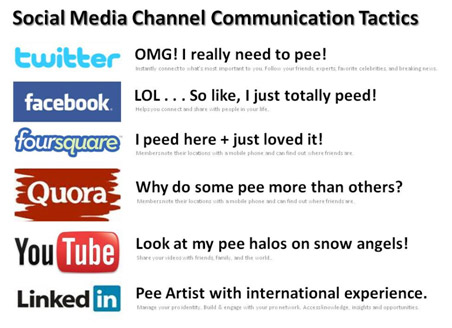Use marketing strategies consistently to grow your valued brands:
Over the past 5 years we’ve developed many different campaigns for a wide variety of clients in many different business categories across Manitoba. In the process we’ve come across a handful of practices that seem to separate the category winners from their competitors.
If you think you’ve got the best product or service and want to go global, here are six mission critical marketing strategies and tactics that need to become integral to your operations.
No.1: Leading Brands March to their Own Drum
If you’re marching to the beat of your own drum, you’re a leader. If you’re not, you’re a follower. It’s that simple. Leaders think differently and seize the opportunities found on the path they choose. The products and services they offer are a tangible response to a problem or opportunity they have discovered. While leaders are aware of what their competitors are doing, the competitive activity (or lack of it) helps define their pace and timing helping them decide when and where to strike out in new directions.
Product Managers are followers who “compete” for established trade routes with “bigger”, “better”, “faster” or “cheaper” solutions.
Leaders don’t talk price unless they’re in the discount business, because “price is what you should talk about when you have nothing else left to say”. Talking money trains customers and prospects to think about getting the best price, not the best value let alone the best product.
Leaders hunt relentlessly for meaningful ways to differentiate themselves from the competition. Leaders defend their territory with multiple brand advantages that, in the consumer’s mind, represent a mental, physical or spiritual advantage. Price is not an advantage. For most brands it is their Achilles heel.
Leaders reinvent themselves and the brands they serve time and time again because change is their constant.
No.2: Leaders Understand, Respect and then Redefine the Economic Terrain
Many leaders come across as adversarial because they’re not “team players”. Guess what? They’re not. They’re team-leaders. There’s a difference. Leaders get clear vision by doing a lot of homework (called research) to help them and the brand they serve understand the economic terrain. When they have enough data, the terrain looks like a geological map that defines – in three dimensions – any area’s business strengths, weaknesses, opportunities and threats.
Leaders surround themselves with insightful stakeholders that help them define a business model that maximizes opportunity and minimizes stakeholder investment risk. Solid values ensure that all customer-facing team members handle opportunity and adversity in the same predictable and prescribed manner – buying management time to decide if an alternate course of action is warranted or ill-advised.
No.3: Leaders Create or Manage Brands that Serve Tomorrow, not Yesterday
Leaders reinvent themselves and the brands they serve time and time again because change is their constant. Their experience is made up of successes and failures that help define the frequency and odds of success and failure for everything from OBT to USP.
Past wins fund tomorrow’s research.
Past losses are write-offs, little more.
No.4: Leaders Understand that Audience Segmentation is Mission Critical
Leaders analyze their sales using metrics that are congruent with their brand’s mission, vision and values and define their ideal target group as those customers who enable them to achieve their stated brand goals.
1. They build segmented databases featuring primary and secondary clients, prospects and suspects.
2. They take care of key accounts themselves – because having skin in the game matters.
3. They assign dedicated account managers to their high volume \ high value clients.
4. E-marketing allows them to stay in touch with (secondary) clients, prospects and suspects in transition.
5. Their supports build and refine suspect databases that turn suspects into prospects.
6. They re-market to increase product and service conversion rates.
7. They use both online and offline advertising to move new suspects through the marketing funnel.
No.5: Leaders Partner People, Products and Services
Leaders segment their products and services along one line, their audience along another line and media alternatives along a third line to ensure the right product is presented to the right audience using the right medium. They take pride in their ability to create opportunities for their brands, customers and prospects to meet.
Here are two examples of how leaders might use media insights to define their message and their moment.
A. How people use the Internet to find washrooms:
(Source: Google Engage, March 2012)
5% Search
20% e-mail
11% e-commerce
38% content
26% Social Media Channels
B. How people use Social Media Channels to discuss washroom activity:
(Source: wehrmann.ca | Blog entry #109)

Leaders also listen well and keep listening to ensure their brand remains aligned with their customers’ needs.
N0.6: Leaders Stay Out of the Trenches (most of the time)
While leaders do not underestimate the importance of re-winning their customer’s loyalty with every transaction, they do understand that the game is lost if they lose perspective. Leaders enter trenches to reacquaint themselves with day-to-day issues and keep in touch with key accounts, but leaders keep on moving because they need to keep one eye on and remain one step ahead of the competition.
In today’s fast paced world, leaders and their key supports use business, personal and social sites to market their product and services, monitor the competition, communicate and survey their audiences… all in real time.
Their online media sites are like familiar beacons that serve them well 24/7.
Because they march to their own drum, they have far more genuine news and views to share and have more interesting stories to tell (than the 5,000,000,000th follower). Leaders tell the world who they are, what they’re up to and what sets them apart from others.
They network with like-minded brands and people.
And in time more and more followers follow.
Frank Wehrmann
Director
6P Marketing
